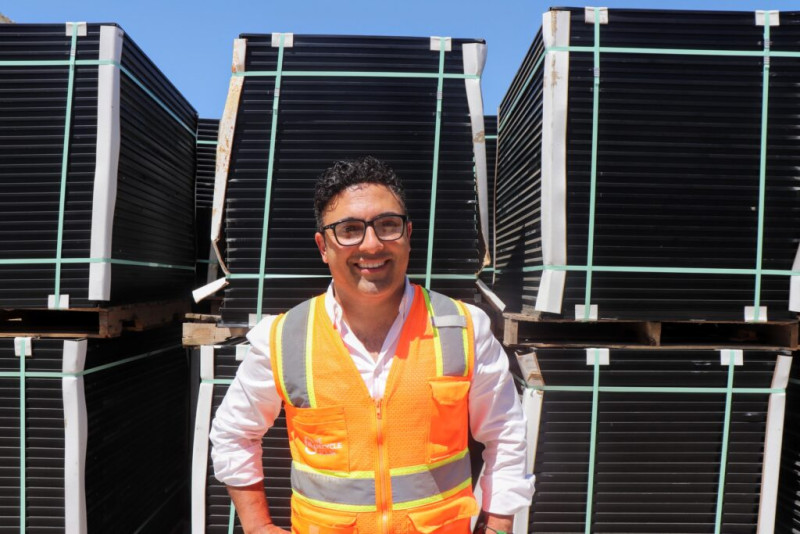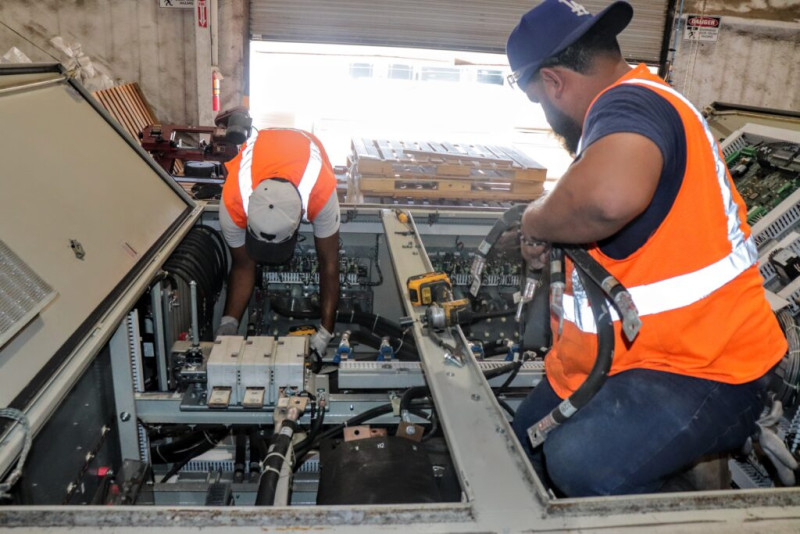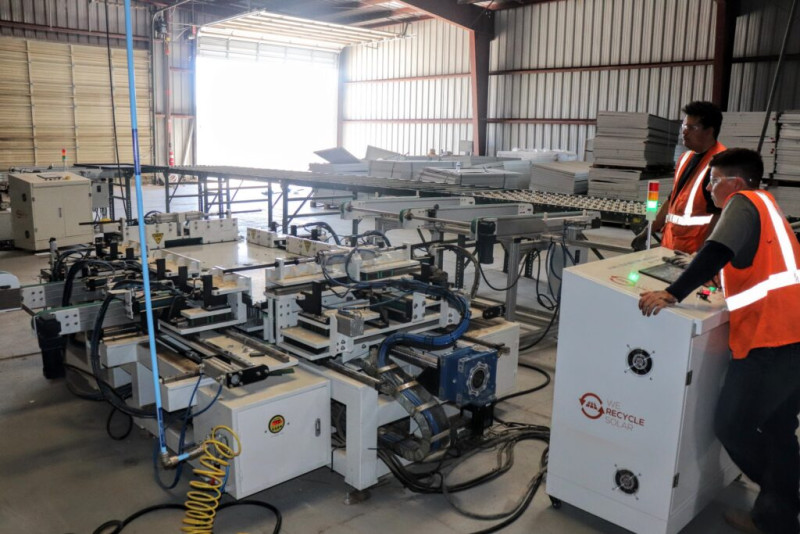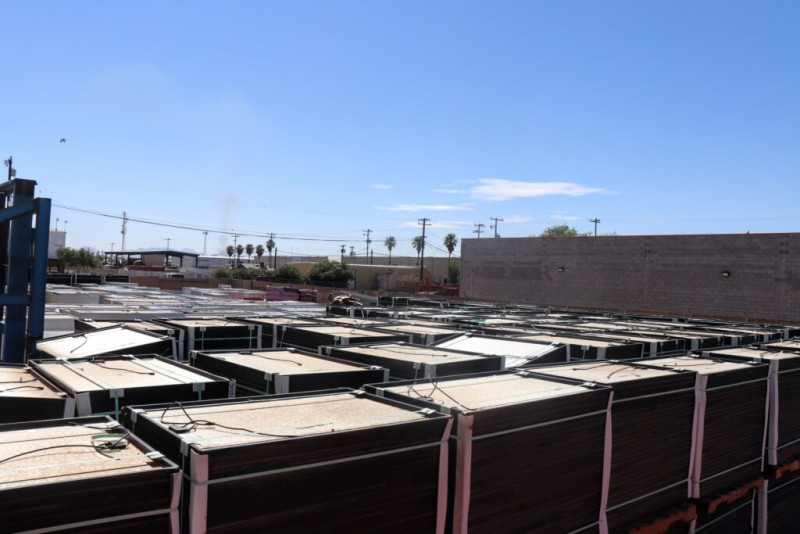Making Solar Energy as Clean as Can Be Means Fitting Square Panels Into the Circular Economy
Even for the most enthusiastic boosters of renewable energy, it’s hard to argue that solar panels provide truly clean electricity if, at the end of their lives, many of them end up in landfills.
But keeping solar cells out of the dump requires a market for recycled solar materials that is much more robust than what currently exists and policies that incentivize companies to recycle their panels and use recycled materials when they’re building new ones. Still, for many experts, the first step in creating such a “circular economy” in which decommissioned solar components are repurposed in new ones, is to prohibit the disposal of solar panels in landfills at all.
“We have to come together and say, ‘there’s absolutely no landfill policy.’ Let’s start there,” said Adam Saghei, CEO of We Recycle Solar, one of the nation’s only utility-scale solar recycling companies, which is based in Yuma, Arizona.

To keep panels out of landfills, the company prioritizes reusing PV panels that still have life in them. They put about 60 percent of the whole panels that come through their doors back on the market, often for about half their original price. Of the remaining 69 million pounds of material they receive in a year, 99 percent can be taken apart and recycled back into the supply chain, Saghei said.
Energy upgrades and changes in regulatory standards often cause businesses to decommission their solar projects long before they’ve exhausted their ability to generate electricity. The solar industry has found that there is indeed a market for used solar panels. A 300-watt panel may not suit the needs for a large company over time, Saghei said, but can help an RV owner, for example, power their home on wheels, where it could continue producing electricity for more than a decade. Reused panels go through an extensive quality control process before being sold at a discounted rate to their customers.
“It’s a win-win for everybody,” he said.
Creating a Circular Economy
The majority of panels sent to recycling centers will come from decommissioned, large-scale projects like solar farms or commercial rooftop buildings, according to Saghei.
The first step in the process is to check for reuse potential. Technology like photo luminescence can scan for cracks or other integrity issues. Panels that are still in sound condition can be resold to someone who can put their remaining capacity to generate electricity to use.
We’re hiring!
Please take a look at the new openings in our newsroom.
See jobsWhatever can’t be resold then goes through the materials separating process, with recycling companies striving to recover as much of the metals, like copper, as possible. Pieces are then sold to a secondary market or brokers for fine or nonferrous metal.
Having a circular economy in the solar industry means businesses will recycle as much as they can from panels being retired, extending the component materials’ life cycles and reducing overall waste. But as most of the technology to refine elements from decommissioned solar panels is still in its beginning stages, separating more valuable materials from other parts of the old components is difficult.
Take the glass in a solar panel. It makes up 80 percent of most solar panel’s weight, but it is difficult to maintain a high enough quality of glass throughout the recycling process to be able to sell it to glass companies for reuse, experts said. Many companies are looking for other options in which imperfect glass blends can be used in glass sandblasting, for example, as a way to recycle the panels even when materials have mixed. Essentially, the more pure the glass can be kept during the separation stage, the greater opportunity companies then have to recycle it into new products.
For Saghei, glass recycling is a great example of reusing materials that can’t stay in the solar panel industry. Partnering with other companies that can also benefit from what would otherwise be considered waste is something he encourages in order to stretch out the use of panels and ultimately protect the environment.
“We don’t have to mine a quarry. We don’t have to go out and disrupt the ecosystem,” he said. “We can take that raw material, and put it back into use.”


New Policies Needed to Incentivize Recycling
But glass is just one problem, and one that is easier to solve than some others, like the cost disparity between recycling solar panels and sending them to the dump.
It currently costs about $5 to put a panel into a landfill, compared to $20 to recycle it, said Taylor Curtis, regulatory and policy analyst at the National Renewable Energy Laboratory.
It doesn’t help that there are no government incentives to promote recycling the panels. While many industry workers are hopeful that will change soon after recent investments by the U.S. Department of Energy into more efficient recycling technology, they believe that because of the pure cost of going greener, new policies must come into play to make that happen.
“There’s no real incentive to recycle right now based on our current regulatory structure,” Curtis said. “There’s really a need for a policy that is designed to incentivize recycling over disposal to kind of help overcome some of those market challenges.”
Current federal regulations treat disposal of panels and recycling them the same, leading to regulations that may be stricter than needed for recycling, she said.
That’s causing issues. Because some solar panels are made with lead, they are labeled as hazardous materials and subject to regulation that limits how many panels can be stored at a facility and for how long. Assuming each panel weighs 50 pounds, Curtis said a recycling facility can only store up to 264 of them a month. That makes transporting them more expensive because not enough can be shipped out be cost effective, she said, and prevents a site from storing enough of them to make their recycling into an economy of scale.
Just how hazardous the lead is is debatable, Curtis said, largely due to the lack of information on just how much lead there is in different solar panels built by various companies. It’s a double-edged sword, Saghei said, because panels’ hazardous classifications create clear obstacles to their recycling, but can also drive policies that keep them out of landfills and the environment.

Before solar panels begin to be decommissioned en masse, policymakers and the industry will need to find solutions to these problems. Fortunately for the industry, there’s time to figure out new solutions and policies to better recycle solar panels. The average life of a solar panel is between 30 and 40 years, but “82 percent of all solar panels installed today are seven years old or less,” Curtis said. Very rarely are solar panels seriously damaged so most of them can be expected to last for at least another decade or so before reaching the end of their lifespans.
Until the industry can create a circular economy, solar energy will only be 50 percent green, said Meng Tao, a professor at Arizona State University and a leading researcher on systems to recycle solar components. But researchers and companies are getting better at recycling the materials, and he expects eventually 90 to 95 percent of a panel’s weight will be able to be recycled.
Some companies are already nearing that number. Suvi Sharma, CEO and cofounder of Solarcycle, said they are able to recover 95 percent of the materials brought into their recycling shop. The company is working on technology that will recycle glass from old panels into new solar glass and more effective methods of separating the metals from solar components, which Sharma said are the most important materials.
”Metals in the panel like the silicon, the silver and the copper are actually less than 3 percent of the panel by weight, but they are more than half of the value of the panel,” he said.
Solarcycle will be opening a lab in Mesa, Arizona soon, where it expects to be part of a hot spot of solar projects and engineering talent. That could lead Arizonans to be concerned about solar recycling’s utilization of water, but Sharma and Saghei contend that there is very little water use during these operations, generally only used to clean parts before separating materials.
Sharma said they are in the business of developing more efficient ways to deal with more types of panels, and those that others might consider mangled beyond use, both of which will be necessary as the U.S. continues to expand solar projects and eventually decommissions those currently operating.
“We’re expecting more than 640 gigawatts to be installed in the next 10 years,” Curtis said, “That’s nearly five times what is installed today.”
Sharma said that Solarcycle is already starting to receive the first wave of old solar panels at their facility. Their overarching goal is to keep these panels out of the landfill.
“We’re seeing more and more people step up,” said Saghei. “I think that when you do something for the right reason, everything else falls into place.”
Share this article
Disclaimer: The copyright of this article belongs to the original author. Reposting this article is solely for the purpose of information dissemination and does not constitute any investment advice. If there is any infringement, please contact us immediately. We will make corrections or deletions as necessary. Thank you.







